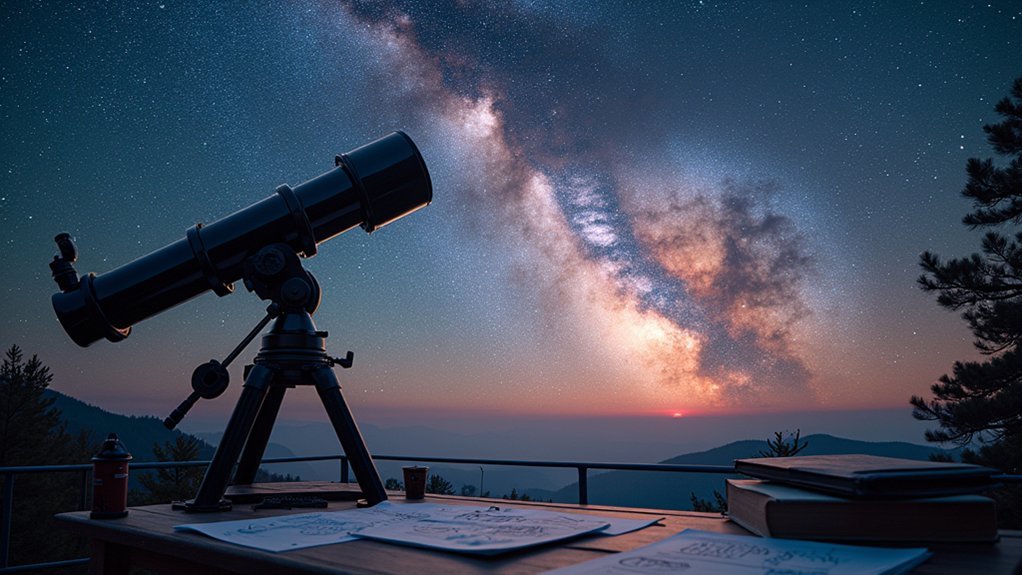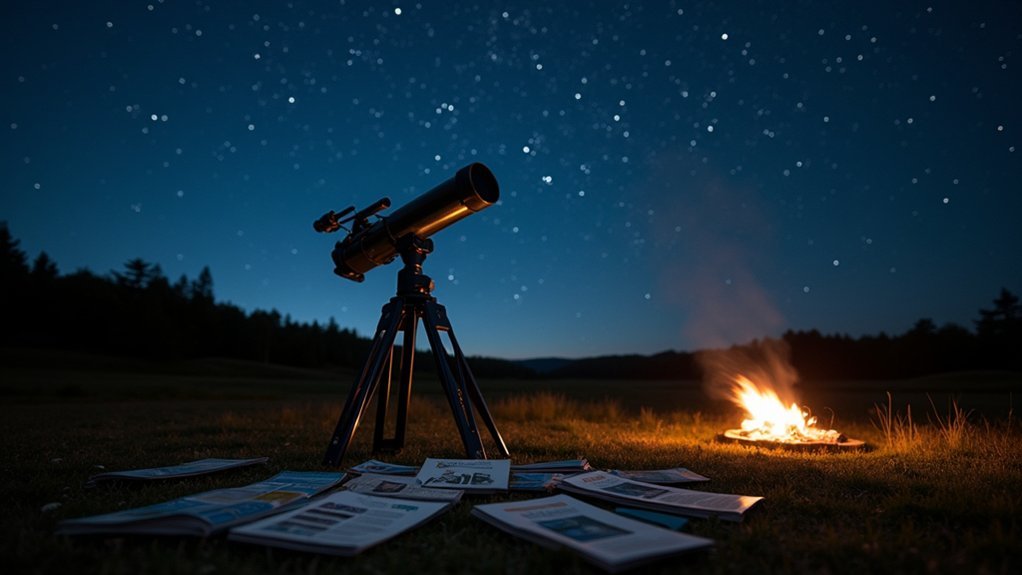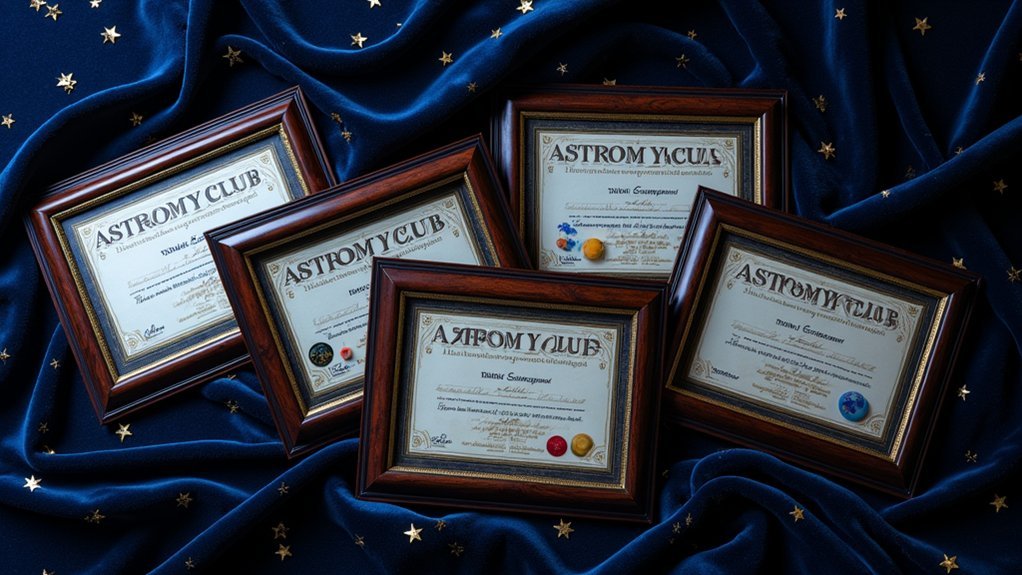Students can measure galaxy distances today with accessible techniques ranging from simple to sophisticated. You can start with DIY parallax measurements using just a ruler and protractor, then progress to analyzing Cepheid variable stars or surface brightness fluctuations with digital cameras and telescopes. For more distant galaxies, redshift calculations and computational methods using open-source data from NASA provide greater reach. These methods build upon each other, creating your personal cosmic distance ladder for exploring the universe’s vastness.
How Students Can Measure Galaxy Distance Today

Several cutting-edge techniques now enable students to measure cosmic distances with impressive accuracy. You can apply methods that professional astronomers use, starting with the parallax angle technique for nearby stars, measuring their apparent shift against background objects as Earth orbits the Sun.
For galaxies beyond our stellar neighborhood, you’ll find the Surface Brightness Fluctuations (SBF) method particularly accessible. This technique analyzes brightness variations across a galaxy’s surface to determine distance based on stellar distributions and colors.
When studying more distant galaxies, you can identify Cepheid variable stars, whose predictable pulsation periods correlate directly with their luminosity. By comparing their apparent brightness to known intrinsic brightness, you can calculate accurate distance measurements.
The Tully-Fisher relation offers another approach, connecting galaxy rotation speeds to their distance through spectral analysis.
Understanding the Cosmic Distance Ladder
You’ll discover the cosmic distance ladder operates as a hierarchical system, where each method builds upon measurements from the previous technique.
When you start with parallax for nearby stars, you can use that foundation to calibrate Cepheid variables, which in turn help establish the reliability of Tully-Fisher relations and Type Ia supernovae measurements.
This progressive chain of measurements allows you to extend your reach from our stellar neighborhood to the most distant galaxies billions of light-years away.
Methods Stack Like Ladders
When astronomers measure vast cosmic distances, they rely on a series of interconnected techniques known as the cosmic distance ladder. This methodical approach starts with nearby measurements and builds toward the most distant galaxies in our universe.
You’ll notice how each method depends on the previous one. First, you can use trigonometric parallax to measure distances up to 100 parsecs. These measurements then calibrate Cepheid variables, powerful standard candles that extend your reach to about 20 million parsecs.
Once you’ve established Cepheid distances, you can calibrate Type Ia supernovae, which allow you to measure distances billions of parsecs away.
The Tully-Fisher relation adds another rung to your ladder by connecting a galaxy’s rotation to its luminosity. In astronomy, each method strengthens the next, creating a robust framework for cosmic exploration.
From Parallax To Supernovae
Let’s explore how the cosmic distance ladder actually works by examining its critical rungs.
You’ll start with parallax, measuring the apparent shift of nearby stars against background objects—this works reliably up to 10,000 light years.
When stars become too distant for parallax, you’ll rely on Cepheid variable stars, whose pulsation periods directly correlate with their luminosity, extending your reach to about 20 million parsecs.
For measuring distances in space beyond our galactic neighborhood, you’ll need Type Ia supernovae.
These stellar explosions occur when white dwarfs reach critical mass and provide consistent brightness visible up to 1 billion light years away.
The Tully-Fisher relation offers another approach, using galaxy rotation speeds to determine luminosity and distance—crucial for understanding galaxy formation across cosmic history.
Building On Prior Steps
Understanding the cosmic distance ladder requires recognizing how each measurement method builds upon previous ones. When you’re learning to measure distances to galaxies, you’ll start with nearby objects using parallax techniques, which establish the foundation for all subsequent measurements.
Once you’ve mastered parallax, you can explore how astronomers use standard candles like Cepheid variable stars, which relate brightness variation periods to their actual luminosity. These stars help calibrate measurements out to 20 million parsecs, allowing you to reach far beyond our local neighborhood.
The cosmic distance ladder continues with the Tully-Fisher relation for spiral galaxies, connecting their rotation speeds to luminosity.
Finally, you’ll see how astronomers calibrate Type Ia supernovae using previously established Cepheid measurements, extending our ability to measure cosmic distances even further.
Mastering Parallax Measurements With Simple Tools
You can construct your own angle measuring device using a ruler attached to a protractor to track a star’s position change over several months, making parallax measurements accessible in any classroom.
With these measurements, you’ll calculate stellar distances using the simple formula d = 1/p, where p is your observed parallax angle in arcseconds.
Your DIY stellar distance calculator will help you determine distances up to about 100 parsecs away, which you can verify against online catalogs to test your accuracy.
Homemade Angle Measuring
Amateur astronomers and students can measure cosmic distances with surprisingly simple tools found at home.
You’ll need just a ruler, protractor, and possibly binoculars to conduct your own parallax measurements.
Set up your experiment by observing a star’s position against distant background stars from two locations on Earth, simulating Earth’s orbital positions. Measure the baseline distance between your observation points, then use your protractor to determine the angle of apparent shift.
Calculate the star’s distance using the formula: distance in parsecs = 1/parallax angle (in arcseconds).
Enhance your observations with binoculars or a simple telescope for greater accuracy.
DIY Stellar Distance Calculators
Creating your own stellar distance calculator transforms abstract astronomical concepts into tangible learning experiences. With the parallax method, you’ll measure the distances to nearby stars by observing position shifts over six months.
Start with a simple DIY parallax setup: ruler, smartphone, and measuring tape. Mark your observation positions, capture images of your target star, and measure the apparent shift. Using the formula p = 1 AU/d, convert your parallax angle to parsecs, revealing actual astronomical distances.
For accuracy, take multiple measurements and average your results to minimize atmospheric distortions. Compare your calculations with established databases to refine your technique.
While you can’t directly measure the distance to a galaxy with this method, mastering stellar measurements builds your understanding of cosmic scale and fundamental astronomical principles.
Standard Candles: Finding Celestial Yardsticks

When astronomers need to measure vast cosmic distances, they rely on “standard candles” – celestial objects with predictable, known luminosities. You can use these same techniques to calculate galactic distances in your own projects.
| Standard Candle Type | Distance Range | Key Feature | Student Application |
|---|---|---|---|
| Cepheid Variables | Up to 20M parsecs | Period-luminosity relationship | Period timing with digital photography |
| Type Ia Supernovae | Billions of parsecs | Consistent peak brightness | Archive data analysis |
| Tully-Fisher Relation | Intermediate galaxies | Rotation-luminosity correlation | Spectral line measurements |
| Surface Brightness | Nearby galaxies | Angular size vs. brightness | Digital image processing |
Redshift Analysis for Distant Galaxy Measurement
Three fundamental principles enable students to measure distances to far-away galaxies using redshift analysis.
When you observe the wavelength stretching of light from distant galaxies, you’re witnessing cosmic expansion firsthand. Calculate redshift (z) using the formula z = (λ_observed – λ_emitted) / λ_emitted, then apply Hubble’s Law to determine how far these galaxies are from Earth.
Observe distant galaxies, calculate redshift, apply Hubble’s Law, and unveil the cosmic distances that shape our expanding universe.
- Higher redshift values indicate greater distances—some galaxies exist billions of light years away.
- Spectroscopic observations provide precise measurements beyond what an Astronomical Unit (AU) can practically reference.
- The relationship between redshift and distance reveals the universe’s expansion history.
- You can measure how far galaxies using special software that analyzes spectral lines, even in a classroom setting.
Surface Brightness Fluctuations for Student Projects

Although less widely known than redshift analysis, Surface Brightness Fluctuations offer students an accessible method to measure galaxy distances with remarkable precision. The technique works by analyzing intensity variations or “bumps” in galaxy images—closer galaxies appear bumpier due to their densely arranged stars.
You can apply this technique using telescope images or online databases, gaining hands-on experience with astronomical distance measurement. The method examines how stars distribute within galaxies, expressing distances in parsecs rather than kilometers.
This approach is particularly effective for nearby galaxies, where surface brightness patterns are more discernible. By mastering SBF analysis, you’ll enhance your understanding of galaxy properties while contributing to broader studies of cosmic structure and evolution—skills valuable for any aspiring astronomer.
Digital Imaging Techniques for Amateur Astronomers
Despite limited equipment compared to professional observatories, amateur astronomers can measure galactic distances using accessible digital imaging techniques.
Amateur stargazers can now unlock cosmic measurements once reserved for professionals through modern digital imaging.
You’ll need a digital telescope with a CCD camera to capture high-resolution images that reveal details professional astronomers once monopolized.
- Use long-exposure photography to collect light from distant galaxies, making faint objects visible
- Apply the photometric method to measure standard candles like Cepheid variable stars
- Process your images with software like AstroImageJ to analyze surface brightness fluctuations
- Calibrate your findings against online databases like Sloan Digital Sky Survey to verify your place on the cosmic distance ladder
Computational Methods Using Open-Source Data
The digital astronomy techniques previously discussed become even more powerful when combined with vast open-source datasets now available to students. You can access NASA’s Hubble Legacy Archive and similar repositories to download galaxy images needed to measure distances to galaxies through computational techniques like surface brightness fluctuations.
Python’s Astropy library offers essential tools for implementing measurement algorithms. With this package, you’ll analyze galactic structures by applying methods like the Tully-Fisher relation or Cepheid variable analysis. These calculations convert raw imaging data into meaningful distance measurements.
Consider joining citizen science projects like Galaxy Zoo to further develop your galaxy classification skills while contributing to astronomical research. As you work with these resources, you’ll gain valuable experience analyzing real astronomical data—skills that transfer directly to more advanced research or data science applications.
Building Your Own Distance Measurement Models
Creating your own cosmic distance ladder models offers a hands-on approach to understanding how astronomers measure vast galactic distances.
You can start with parallax techniques for nearby stars (up to 100 parsecs), then extend your reach using standard candles like Cepheid variable stars to measure distances to galaxies millions of light years away.
- Build a parallax-based model using the Astronomical Unit (AU) as your foundation, measuring the apparent shift of stars against distant backgrounds.
- Implement Cepheid variable star analysis by correlating their periodic brightness variations with intrinsic luminosity.
- Apply the Tully-Fisher relation by measuring galaxy rotation speeds to determine distances up to 15 million light years.
- Simulate Type Ia supernovae observations to calculate distance to objects by comparing observed versus standard brightness values.
Frequently Asked Questions
How Do We Measure the Distance of Galaxies?
You measure galaxy distances through parallax for nearby objects, Cepheid variables as standard candles, the Tully-Fisher relation for spiral galaxies, Surface Brightness Fluctuation technique, and redshift measurements for extremely distant galaxies.
How Do We Measure in a Galaxy?
In a galaxy, you’ll measure distances using parallax for closest objects, Surface Brightness Fluctuations for patterns, Cepheid variables as standard candles, Tully-Fisher relation for spirals, and redshift for the furthest objects.
Which Method Is Used to Measure the Distance to the Most Distant Galaxies?
You’ll find redshift is the primary method for measuring the most distant galaxies. By analyzing how much light wavelengths stretch due to universal expansion, astronomers can calculate distances billions of light-years away.
How to Measure Distance in Space by Using Light Years?
You’ll measure space distances in light years by determining how long light takes to travel from an object to Earth. Multiply the travel time in years by the speed of light to find the distance.
In Summary
You’ve now learned several methods to measure cosmic distances, from parallax to redshift. With today’s technology and open-source data, you’re equipped to calculate galaxy distances right from your classroom or home. These techniques connect you to centuries of astronomical discovery while using modern tools. By building your own models, you’re participating in real science—just like professional astronomers, but on a scale that’s accessible to students.





Leave a Reply